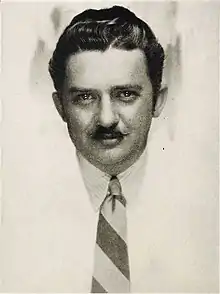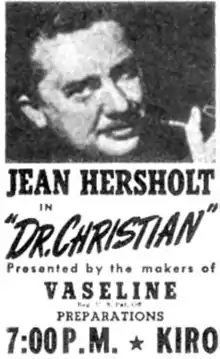Jean Hersholt | |
|---|---|
 Hersholt in 1929 | |
| Born | Jean Pierre Carl Buron[1] 12 July 1886 |
| Died | 2 June 1956 (aged 69) Los Angeles, California, U.S.A. |
| Resting place | Forest Lawn Memorial Park, Glendale, California |
| Other names | Jean Pierre Hersholt Jean Buron Hersholt |
| Occupation(s) | Actor (film and radio), philanthropist, humanitarian, literary editor / translator |
| Years active | 1906–1955 |
| Spouse |
Via Hersholt (m. 1914) |
| Children | 1 son |
Jean Pierre Carl Buron (12 July 1886 – 2 June 1956), known professionally as Jean Hersholt, was a Danish-American actor. He is best known for starring on the CBS radio series Dr. Christian (1937–1954) and inspiring later subsequent TV series (1956-1957), along with co-starring in the Shirley Temple film Heidi (1937).[2] Asked how to pronounce his name, he told to The Literary Digest, (major influential magazine of current affairs / news, opinion and cultural affairs, published 1890-1938) "In English, her'sholt; in Danish, hairs'hult."[3] Of his total motion picture credits during 1924 to 1955, 75 were silent film and 65 were "talkies" - 140 total; he directed four.
Early life
Hersholt was born Jean Pierre Carl Buron on 12 July 1886, in Copenhagen, the capital of Denmark. Hersholt claimed later to be born into a family of actors,[4] but in reality, both of his parents: Henri Pierre Buron, the son of a French Roman Catholic father and a Danish Protestant (Evangelical Lutheran / Church of Denmark) mother - Clara (née Petersen), the daughter of a Danish Protestant father and a Danish Jewish mother, were hairdressers, though the father later was a cigar and wine merchant /vendor.[5] Hersholt appeared in two of the first short films of the Danish film studio Nordisk Film in 1906, but did not find much success in his youthful early years in Denmark.[6] Hersholt emigrated to the United States in 1913, and spent the remainder of his acting career in America.
Career

Hersholt's best remembered film roles include as Marcus Schouler in the influential and legendary early film director Erich von Stroheim's 1924 silent film classic Greed and a decade later co-starring with world-famous child actress Shirley Temple as her beloved grandfather living in the remote Alps in the 1937 film version of the classic 1880 children's book, Heidi, written by Swiss author Johanna Spyri. During his long career in the movies, his roles ran the gamut from early silent film villains to secondary parts in which his mild Danish language accent and pleasant voice suited him to depict a succession of benevolent fathers, doctors, professors, and European noblemen. Hersholt's last screen role was in the 1955 movie Run for Cover.
In The Country Doctor (1936), a movie starring the famous Dionne quintuplets children, Hersholt portrayed a Dr. John Luke, a character based on Dr. Allan Roy Dafoe, the Canadian obstetrician, who delivered and cared for the Dionne quintuplets. Two sequels followed. Hersholt wanted to do the role on radio, but could not get the rights. He decided to create his own doctor character for radio, and since he was an enthusiast / fan of fairy tales anthology author Hans Christian Andersen, he borrowed that name for his character portrayal of the philosophical "Dr. Paul Christian" who practiced in the typical Midwestern town of River's End with the assistance of Nurse Judy Price and occasionally others. With the opening theme music of "Rainbow on the River", Dr. Christian was introduced on the Columbia Broadcasting System (CBS) radio network on 7 November 1937 on 'The Vaseline Program', or also more often known as Dr. Christian's Office and later the title was shortened to just Dr. Christian.
The small-town physician's good humor, innate common sense, and scientific training helped drive off a series of villainous types who tried to interfere with the usual peaceful pleasant pace and lifestyle of the town of River's End. Produced by Dorothy McCann, the radio series soon became a popular long-running hit, continuing on the CBS network for 17 years until 6 January 1954, with Hersholt so strongly identified with the role that he even received mail asking for real life medical advice. Various spin-offs were produced creating one of the earliest media franchises, as Hersholt co-wrote a Dr. Christian novel and made a series of six family feature films as Dr. Christian in a franchise over two years, from 1939 to 1941, (for instance Dr. Christian Meets the Women in 1940).
Two years after the conclusion of the long-running radio program, in 1956, his Dr. Christian character made the transition to television and its different unique programming style. Interestingly, it was scripted by a young Gene Roddenberry, (later to become famous with the beginnings in 1966 of the original TV series 'Star Trek' and subsequent renowned science fiction franchise over the next few decades). The new 'Dr. Christian' TV show was a bit different from the radio series with introducing a new younger character portrayed by Macdonald Carey as the elder Christian's nephew, "Dr. Mark Christian". It was syndicated through CBS and its Ziv Television production company and ran for two seasons, 1956-1957. Much of it was shown on the air at odd times on local stations that subscribed throughout the country, unfortunately seen after Jean Hersholt had died in early 1956.
From the late 1930s through the mid '50s, Neil Reagan, (brother of the famous actor, later as a General Electric Company traveling industry spokesman, and future Governor of California and America's 40th President Ronald Reagan), directed the earlier CBS radio series Dr. Christian, with Jean Hersholt.
In 1939, Hersholt began his wider social interests and helped form the Motion Picture Relief Fund to support Hollywood's various levels of industry employees with medical care when they were down on their luck or struck with illness or becoming elderly. This was only four years after the beginning of America's "social net" with the passage of Social Security old age pension system by the Roosevelt administration. The fund Hersholt supported was used to create the Motion Picture Country House and Hospital in Woodland Hills, California, His charitable work also led to the creation after his death in 1956 of the Jean Hersholt Humanitarian Award, an honorary Academy Award ("Oscar") given to an "individual in the motion picture industry whose humanitarian efforts have brought credit to the industry". The fund was later expanded to include those working in the television field.[7]
Serving as president of the Academy of Motion Picture Arts and Sciences with its many growing activities to promote and preserve American cinema, Hersholt presented to several of the American motion pictures / film industry "founders" - Colonel William N. Selig, Albert E. Smith, George K. Spoor, and Thomas Armat with special awards on March 20th, 1948 at the 20th anniversary of the academy's founding. These were often called "the Men Who Invented Hollywood".[8]
Hersholt's large collection of famous Danish author Hans Christian Andersen books and other materials is now in the special collections division of the Library of Congress in Washington, D.C.. He translated over 160 of Andersen's fairy tales into the English language. These were published in 1949 in six volumes as The Complete Andersen, this work is "... rated as The standard translation, being one of the best" in English cited by the Hans Christian Andersen Center of the University of Southern Denmark.[9]
Hersholt was appointed a knight of the Danish-American Order of the Dannebrog and awarded a medal in 1948, partly due to this literary academic endeavor.[10]
An elderly Hersholt full of accomplishments appeared 3 - 1/2 years before his passing as the mystery guest on August 31st, 1952 on the popular long-running CBS-TV panel/quiz show What's My Line? hosted by John Charles Daly which ran during the 1950s and into the 1960s.
Family
Hersholt married Via Andersen on 11 April 1914. They had one son: Allan Hersholt.
He was the paternal half-uncle (by marriage) of actor Leslie Nielsen and former Canadian Deputy Prime Minister Erik Nielsen.[11]
Death

Hersholt died of cancer in Hollywood in 1956, and is interred in Forest Lawn Memorial Park Cemetery in Glendale, California. His grave is marked with a statue of Klods-Hans (English: Clumsy Hans), a Hans Christian Andersen character who left home to find his way in the world — much as Hersholt himself had done.[12]
Honors and awards
Hersholt was honored for his services to the industry twice with an honorary Academy Award, first in 1940 and the second time in 1950, and in his honor the Jean Hersholt Humanitarian Award was named by the Academy of Motion Picture Arts and Sciences.[13] He is one of only 11 people with two stars on the Hollywood Walk of Fame with one at 6501 Hollywood Boulevard for his work in motion pictures and another one at 6701 Hollywood Boulevard for his work in radio.
Selected filmography
Radio appearances
| Year | Program | Episode/source |
|---|---|---|
| 1943 | Lady Esther Screen Guild Theatre | Men in White[14] |
References
- ↑ "Free Family Tree, Genealogy, Family History, and DNA Testing". www.myheritage.com. Retrieved 15 December 2022.
- ↑ Obituary Variety, 6 June 1956, p. 63.
- ↑ Funk, Charles Earle (1936). What's the Name, Please? A Guide to the Correct Pronunciation of Current Prominent Names. New York: Funk & Wagnalls. OCLC 1463642.
- ↑ Current biography yearbook, Volume 5. H. W. Wilson Co. 1945. p. 288.
- ↑ Kastrup, Kim (28 September 2017). "Dansk Hollywood-stjerne var trækkerdreng" [Danish Hollywood star was a rent boy]. Ekstra Bladet (in Danish). Retrieved 1 August 2019.
- ↑ "Jean Hersholt". Danish Film Institute (in Danish). Retrieved 1 March 2018.
- ↑ "Jean Hersholt Humanitarian Award". Academy of Motion Picture Arts and Sciences.
- ↑ Erish, Andrew A. (2012). Col. William N. Selig: The Man Who Invented Hollywood. University of Texas Press. p. 1. ISBN 978-0292728707. Retrieved 8 August 2019.
- ↑ Lars Bo Jensen (2008). "The Complete Andersen – Edition info". The Hans Christian Andersen Center, University of Southern Denmark. Retrieved 17 January 2008.
- ↑ "Danish-American Medal Recipient Index" (PDF). Retrieved 13 July 2010.
- ↑ Carr, Jay (13 March 1994). "If Leslie Nielsen has learned anything, it's how to play slapstick with a ... straight face". The Boston Globe. p. 83.
I did learn very early that when I would mention my uncle, people would look at me as if I were the biggest liar in the world. Then I would take them home and show them 8-by-10 glossies, and things changed quite drastically. So I began to think that maybe this acting business was not a bad idea, much as I was very shy about it and certainly without courage regarding it. My uncle died not too long after I was in a position to know him. I regret that I had not a chance to know him better.
- ↑ Andersen, Hans Christian. "Clumsy Hans". Retrieved 13 July 2010.
- ↑ "Jean Hersholt Humanitarian Award". Academy of Motion Picture Arts and Sciences. 2009. Retrieved 20 January 2008.
- ↑ "Allbritton, Louise". radioGOLDINdex. Archived from the original on 28 May 2015. Retrieved 26 May 2015.
External links
- Jean Hersholt at IMDb
- Jean Hersholt: The Complete Andersen
- Jerry Haendiges Vintage Radio Logs: Dr. Christian
- Literature on Jean Hersholt
- The Jean Hersholt Collections at the Library of Congress includes early editions of Hans Christian Andersen's writings and his papers; first editions of the writings of Hugh Walpole and Sinclair Lewis and related papers.
- Jean Hersholt at Library of Congress, with 55 library catalogue records